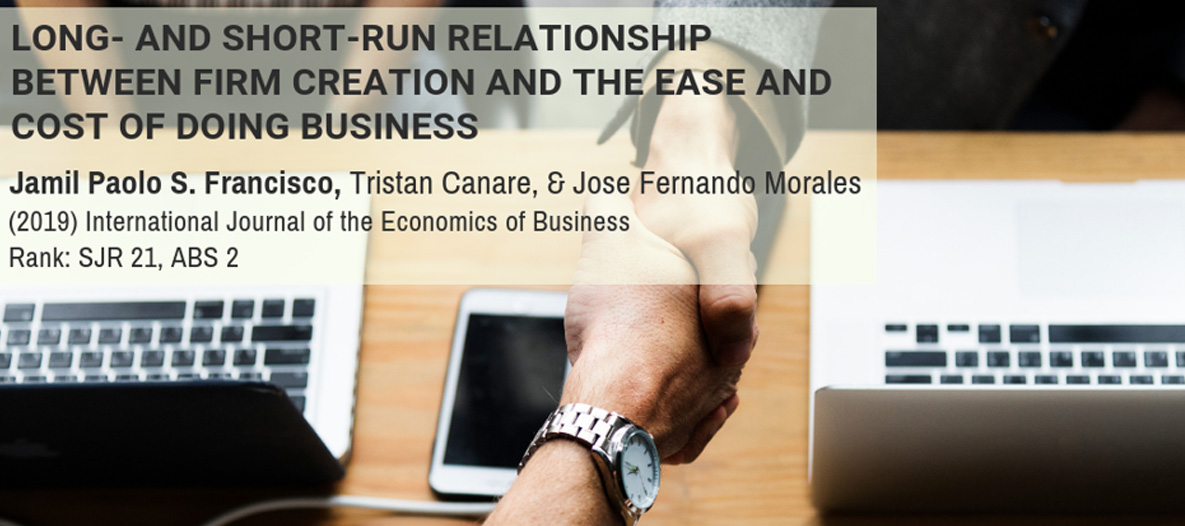To promote growth and development of the private sector, regulators in many countries have implemented reforms aimed at simplifying the process, reducing the time, and decreasing the cost of registering new businesses. This policy is supported by existing literature providing evidence that business entry barriers in general adversely affect growth and firm creation through such channels as decreasing factor productivity, impeding technological growth, discouraging entrepreneurship, and reducing foreign direct investments, among others.

While several studies using cross-country data have found evidence that firm entry barriers limit business creation, there appears to be a lack of empirical analysis using within-country or sub-national data from specific countries, including the Philippines. This is important because the cost and ease of doing and starting a business can vary within countries, particularly those that are decentralized and those with highly uneven economic conditions. In the Philippines, for example, the Local Government Code devolved many functions to the local governments. In addition, one of the first steps in establishing a business – getting a business permit – is handled by city and municipal governments. Development in the country is also highly unequal across the regions.
To address this, we conducted a study that attempted to determine the relationship between the ease and cost of doing business on one side of the equation, and business creation on the other, using data from Philippine cities and municipalities. Specifically, it aimed to determine if more new businesses are created in cities and municipalities where it is easier and less costly to do business, after controlling for other factors that affect business creation.
We used 19 indicators from the National Competitiveness Council’s (NCC) Cities and Municipalities Competitiveness Index (CMCI) – an annual ranking of competitiveness of cities and municipalities in the country – to represent the cost and ease of doing business in each city/municipality. We regressed the average annual number of new businesses registered in the city or municipality for the years 2011 to 2015 on indexes of the ease and cost of doing business based on the standardized value of these indicators, alongside other control variables reflecting economic activity and governance.
Separate regressions using only cities and only third- to sixth-class municipalities were also run to determine if the relationship of business creation with the ease and cost of doing business was the same across localities with different levels of development and economic conditions.
As expected, we found that more businesses were created in areas where it was both less costly and easier to do business. However on its own, the overall ease of doing business index was found to be insignificant. On the other hand, the overall cost of doing business had a strong significant relationship with business creation.

Disaggregating the indexes into individual indicators of the cost and ease of doing business yield similar results, suggesting that lower cost of doing business was a significantly greater driver of business creation than better ease of doing business. The significant specific indicators of business creation were lower minimum wage, lower cost of electricity, and lower cost of land from the ‘cost’ side; and only the number of days to process a new business permit from the ‘ease’ side.
Further analysis also suggests that the relationship between firm creation and the ease and cost of doing business was not constant across cities and municipalities with different levels of economic development. Among third- to sixth-class municipalities, no cost and ease of doing business variable, in aggregate or individually, appeared to be significant drivers of firm creation.
These findings have important policy implications. While ease and cost of doing business combined do encourage business creation, better ease of doing business on its own is not as strong a determinant of firm creation as is lower cost of doing business. Understandably, many governments focus on improving ease of doing business indicators such as the number of days or steps to process new permits since these are well under their locus on control. However, more impactful would be finding solutions to reduce the cost of doing business, which often require long term action.
For those interested, you may secure a copy through this site: https://doi.org/10.1080/13571516.2018.1558636

Citation: Canare, T., Francisco, J. P., & Morales, J. F. (2019). Long- and Short-run Relationship Between Firm Creation and the Ease and Cost of Doing Business. International Journal of the Economics of Business (ABS 2), 1-25. DOI: 10.1080/13571516.2018.1558636





